Can Measurement and Input Uncertainty Explain Discrepancies Between the Wheat Canopy Scattering Model and SMAPVEX12 Observations?
Abstract
1. Introduction
2. Models and Materials
2.1. Wheat Canopy Scattering Model
2.2. SMAPVEX12 Campaign
2.2.1. Ground Measurements
2.2.2. Remote Sensing Data
3. Methods
3.1. Overview
3.2. SAR Data Processing
3.3. Simulation of L-Band Backscatter Using WCSM
3.4. Uncertainty Analysis
3.4.1. Simulation Uncertainty—The Sobol’ Approach
3.4.2. Specifying the WCSM Input Uncertainties
3.4.3. Backscatter Observation Uncertainty
4. Results
4.1. Uncertainty Analysis
4.1.1. Simulation Uncertainty
4.1.2. Backscatter Observation Uncertainty
4.2. L-Band Backscatter Coefficients Simulated by WCSM
5. Discussion
5.1. Interpretation of Discrepancies Using Simulation and Observation Uncertainty
5.2. Potential Causes of Discrepancies Between Observed and Simulated Backscatter
5.3. Implications of Uncertainty Analysis
6. Conclusions
Author Contributions
Funding
Data Availability Statement
Acknowledgments
Conflicts of Interest
Abbreviations
| SAR | Synthetic Aperture Radar |
| WCSM | Wheat Canopy Scattering Model |
| AIEM | Advanced Integral Equation Model |
| SMAPVEX12 | Soil Moisture Active Passive Validation Experiment 2012 |
| UAVSAR | Uninhabited Aerial Vehicle Synthetic Aperture Radar |
| GRD | Ground Range Detected |
| ACF | Autocorrelation Function |
| RMS height | Root Mean Square height |
| CWC | Crop Water Content |
| RMSE | Root Mean Square Error |
Appendix A

Appendix B

Appendix C
| Site-ID | Incidence Angle (Degrees) | |||
|---|---|---|---|---|
| 31603 | 31604 | 31605 | 31606 | |
| 31-2 | - | - | - | 26.6 |
| 31-11 | - | - | - | 25.7 |
| 31-14 | - | - | - | 26.2 |
| 32-2 | - | - | - | 23.5 |
| 32-11 | - | - | - | 23.4 |
| 32-14 | - | - | - | 23.2 |
| 41-2 | - | - | 26.9 | 37.6 |
| 41-11 | - | - | 25.7 | 36.6 |
| 41-14 | - | - | 26.4 | 37.3 |
| 42-2 | - | - | 24.4 | 35.7 |
| 42-11 | - | - | 24.9 | 36.1 |
| 42-14 | - | - | 24.4 | 35.8 |
| 44-2 | - | - | 27.8 | 38.3 |
| 44-11 | - | - | 28.1 | 38.6 |
| 44-14 | - | - | 28.6 | 39 |
| 45-2 | - | - | 24.8 | 36 |
| 45-11 | - | - | 26.8 | 37.7 |
| 45-14 | - | - | 25.2 | 36.2 |
| 55-2 | - | - | 25.8 | 36.7 |
| 55-11 | - | - | 26.4 | 37.3 |
| 55-14 | - | - | 25.5 | 36.6 |
| 65-2 | - | 32.6 | 42 | 49.3 |
| 65-11 | - | 30.8 | 40.5 | 48.1 |
| 65-14 | - | 31.9 | 41.4 | 48.9 |
| 73-2 | 46.7 | 53.1 | 58.1 | 62.1 |
| 73-11 | 44.9 | 51.6 | 56.7 | 60.8 |
| 73-14 | 45.3 | 51.9 | 56.9 | 60.9 |
| 74-2 | 43.7 | 50.6 | 56 | 60.2 |
| 74-11 | 43.2 | 50.2 | 55.6 | 59.8 |
| 74-14 | 43.2 | 50.1 | 55.4 | 59.6 |
| 81-2 | 39.7 | 47.6 | 53.6 | 58.3 |
| 81-11 | 41.2 | 48.9 | 54.7 | 59.3 |
| 81-14 | 40.4 | 48.1 | 54 | 58.6 |
| 85-2 | 35.7 | 44.5 | 51.2 | 56.5 |
| 85-11 | 35.4 | 44.2 | 50.9 | 56.1 |
| 85-14 | 35.4 | 44.3 | 51.1 | 56.4 |
| 91-2 | 45.6 | 52.2 | 57.4 | 61.5 |
| 91-11 | 44.5 | 51.2 | 56.3 | 60.4 |
| 91-14 | 45 | 51.6 | 56.7 | 60.7 |
| 104-2 | - | - | 27.6 | 38.3 |
| 104-11 | - | - | 25.7 | 36.7 |
| 104-14 | - | - | 26.2 | 37.1 |
| 105-2 | - | - | 25.3 | 36.4 |
| 105-11 | - | - | 23.6 | 35 |
| 105-14 | - | - | 24.3 | 35.6 |
References
- Hosseini, M.; McNairn, H. Using multi-polarization C-and L-band synthetic aperture radar to estimate biomass and soil moisture of wheat fields. Int. J. Appl. Earth Obs. Geoinf. 2017, 58, 50–64. [Google Scholar] [CrossRef]
- Mattia, F.; Le Toan, T.; Picard, G.; Posa, F.I.; D’Alessio, A.; Notarnicola, C.; Gatti, A.M.; Rinaldi, M.; Satalino, G.; Pasquariello, G. Multitemporal C-band radar measurements on wheat fields. IEEE Trans. Geosci. Remote. Sens. 2003, 41, 1551–1560. [Google Scholar] [CrossRef]
- Brown, S.C.; Quegan, S.; Morrison, K.; Bennett, J.C.; Cookmartin, G. High-resolution measurements of scattering in wheat canopies-implications for crop parameter retrieval. IEEE Trans. Geosci. Remote. Sens. 2003, 41, 1602–1610. [Google Scholar] [CrossRef]
- Kim, S.B.; Liao, T.H. Robust retrieval of soil moisture at field scale across wide-ranging SAR incidence angles for soybean, wheat, forage, oat and grass. Remote. Sens. Environ. 2021, 266, 112712. [Google Scholar] [CrossRef]
- Huang, X.; Wang, J.; Shang, J. An adaptive two-component model-based decomposition on soil moisture estimation for C-band RADARSAT-2 imagery over wheat fields at early growing stages. IEEE Geosci. Remote. Sens. Lett. 2016, 13, 414–418. [Google Scholar] [CrossRef]
- Lang, R.H. Electromagnetic backscattering from a sparse distribution of lossy dielectric scatterers. Radio Sci. 1981, 16, 15–30. [Google Scholar] [CrossRef]
- Karam, M.A.; Fung, A.K.; Lang, R.H.; Chauhan, N.S. A microwave scattering model for layered vegetation. IEEE Trans. Geosci. Remote. Sens. 1992, 30, 767–784. [Google Scholar] [CrossRef]
- Fung, A.K.; Fung, H. Application of first-order renormalization method to scattering from a vegetation-like half-space. IEEE Trans. Geosci. Electron. 1977, 15, 189–195. [Google Scholar] [CrossRef]
- Fung, A.K.; Ulaby, F.T. A scatter model for leafy vegetation. IEEE Trans. Geosci. Electron. 1978, 16, 281–286. [Google Scholar] [CrossRef]
- Fung, A.K. Scattering from a vegetation layer. IEEE Trans. Geosci. Electron. 1979, 17, 1–6. [Google Scholar] [CrossRef]
- Ulaby, F.T.; Sarabandi, K.; Mcdonald, K.; Whitt, M.; Dobson, M.C. Michigan microwave canopy scattering model. Int. J. Remote. Sens. 1990, 11, 1223–1253. [Google Scholar] [CrossRef]
- Karam, M.A.; Fung, A.K. Scattering from randomly oriented circular discs with application to vegetation. Radio Sci. 1983, 18, 557–565. [Google Scholar] [CrossRef]
- Karam, M.; Fung, A. Electromagnetic scattering from a layer of finite length, randomly oriented, dielectric, circular cylinders over a rough interface with application to vegetation. Int. J. Remote. Sens. 1988, 9, 1109–1134. [Google Scholar] [CrossRef]
- Ishimaru, A. Wave Propagation and Scattering in Random Media; Academic Press: New York, NY, USA, 1978; Volume 2. [Google Scholar]
- Fung, A. A review of volume scatter theories for modeling applications. Radio Sci. 1982, 17, 1007–1017. [Google Scholar] [CrossRef]
- Frisch, U. Wave Propagation in Random Media, Probabilistic Methods in Applied Mathematics; Academic Press: New York, NY, USA, 1968; Volume 1, pp. 75–198. [Google Scholar]
- Ulaby, F.T.; Moore, R.K.; Fung, A.K. Microwave Remote Sensing: Active and Passive; Vol. III—Volume Scattering and Emission Theory, Advanced Systems and Applications; Artech House: Norwood, MA, USA, 1986. [Google Scholar]
- Chandrasekhar, S. Radiative Transfer; Dover Publications, Inc.: New York, NY, USA, 1960. [Google Scholar]
- Attema, E.; Ulaby, F.T. Vegetation modeled as a water cloud. Radio Sci. 1978, 13, 357–364. [Google Scholar] [CrossRef]
- De Roo, R.D.; Du, Y.; Ulaby, F.T.; Dobson, M.C. A semi-empirical backscattering model at L-band and C-band for a soybean canopy with soil moisture inversion. IEEE Trans. Geosci. Remote. Sens. 2001, 39, 864–872. [Google Scholar] [CrossRef]
- Ferrazzoli, P.; Guerriero, L. Radar sensitivity to tree geometry and woody volume: A model analysis. IEEE Trans. Geosci. Remote. Sens. 1995, 33, 360–371. [Google Scholar] [CrossRef]
- Prevot, L.; Champion, I.; Guyot, G. Estimating surface soil moisture and leaf area index of a wheat canopy using a dual-frequency (C and X bands) scatterometer. Remote. Sens. Environ. 1993, 46, 331–339. [Google Scholar] [CrossRef]
- Bindlish, R.; Barros, A.P. Parameterization of vegetation backscatter in radar-based, soil moisture estimation. Remote. Sens. Environ. 2001, 76, 130–137. [Google Scholar] [CrossRef]
- Steele-Dunne, S.C.; McNairn, H.; Monsivais-Huertero, A.; Judge, J.; Liu, P.W.; Papathanassiou, K. Radar remote sensing of agricultural canopies: A review. IEEE J. Sel. Top. Appl. Earth Obs. Remote. Sens. 2017, 10, 2249–2273. [Google Scholar] [CrossRef]
- Acuña, M.; Ferrazzoli, P.; Guerriero, L. Modeling L-and X-band backscattering of wheat and tests over fields of Pampas. Eur. J. Remote. Sens. 2019, 52, 84–101. [Google Scholar] [CrossRef]
- Toure, A.; Thomson, K.P.; Edwards, G.; Brown, R.J.; Brisco, B.G. Adaptation of the MIMICS backscattering model to the agricultural context-wheat and canola at L and C bands. IEEE Trans. Geosci. Remote. Sens. 1994, 32, 47–61. [Google Scholar] [CrossRef]
- Toure, A.; Thomson, K.; Edwards, G.; Brown, R.; Brisco, B. Applying the MIMICS backscattering model in an agricultural context. Can. J. Remote. Sens. 1991, 17, 339–347. [Google Scholar] [CrossRef]
- Cookmartin, G.; Saich, P.; Quegan, S.; Cordey, R.; Burgess-Allen, P.; Sowter, A. Modeling microwave interactions with crops and comparison with ERS-2 SAR observations. IEEE Trans. Geosci. Remote. Sens. 2000, 38, 658–670. [Google Scholar] [CrossRef]
- Oh, Y.; Sarabandi, K.; Ulaby, F.T. An empirical model and an inversion technique for radar scattering from bare soil surfaces. IEEE Trans. Geosci. Remote. Sens. 1992, 30, 370–381. [Google Scholar] [CrossRef]
- Picard, G.; Le Toan, T.; Mattia, F. Understanding C-band radar backscatter from wheat canopy using a multiple-scattering coherent model. IEEE Trans. Geosci. Remote. Sens. 2003, 41, 1583–1591. [Google Scholar] [CrossRef]
- Fung, A.K.; Li, Z.; Chen, K.S. Backscattering from a randomly rough dielectric surface. IEEE Trans. Geosci. Remote. Sens. 1992, 30, 356–369. [Google Scholar] [CrossRef]
- Yan, W.; Zhang, Y.; Yang, T.; Liu, X. A microwave scattering model for simulating the C-Band SAR backscatter of wheat canopy. Am. J. Remote Sens. 2019, 7, 13–24. [Google Scholar] [CrossRef][Green Version]
- Chen, K.S.; Wu, T.D.; Tsang, L.; Li, Q.; Shi, J.; Fung, A.K. Emission of rough surfaces calculated by the integral equation method with comparison to three-dimensional moment method simulations. IEEE Trans. Geosci. Remote. Sens. 2003, 41, 90–101. [Google Scholar] [CrossRef]
- Ma, C.; Li, X.; Chen, K.S. The discrepancy between backscattering model simulations and radar observations caused by scaling issues: An uncertainty analysis. IEEE Trans. Geosci. Remote. Sens. 2019, 57, 5356–5372. [Google Scholar] [CrossRef]
- Merzouki, A.; McNairn, H.; Pacheco, A. Evaluation of the Dubois, Oh, and IEM radar backscatter models over agricultural fields using C-band RADARSAT-2 SAR image data. Can. J. Remote. Sens. 2010, 36, S274–S286. [Google Scholar] [CrossRef]
- Dong, L.; Baghdadi, N.; Ludwig, R. Validation of the AIEM through correlation length parameterization at field scale using radar imagery in a semi-arid environment. IEEE Geosci. Remote. Sens. Lett. 2012, 10, 461–465. [Google Scholar] [CrossRef]
- Huang, B.; Chen, Y.; He, L.; Tong, L.; Wang, Y. Backscattering modeling of wheat using vector radiative transfer theory. J. Appl. Remote. Sens. 2015, 9, 097093-1–097093-11. [Google Scholar] [CrossRef]
- Brogioni, M.; Pettinato, S.; Macelloni, G.; Paloscia, S.; Pampaloni, P.; Pierdicca, N.; Ticconi, F. Sensitivity of bistatic scattering to soil moisture and surface roughness of bare soils. Int. J. Remote. Sens. 2010, 31, 4227–4255. [Google Scholar] [CrossRef]
- Saltelli, A.; Ratto, M.; Andres, T.; Campolongo, F.; Cariboni, J.; Gatelli, D.; Saisana, M.; Tarantola, S. Global Sensitivity Analysis: The Primer; John Wiley & Sons: Chichester, UK, 2008. [Google Scholar]
- Dobson, M.C.; Ulaby, F.T.; Hallikainen, M.T.; El-Rayes, M.A. Microwave dielectric behavior of wet soil-Part II: Dielectric mixing models. IEEE Trans. Geosci. Remote. Sens. 1985, GE-23, 35–46. [Google Scholar] [CrossRef]
- Ulaby, F.T.; El-Rayes, M.A. Microwave dielectric spectrum of vegetation-Part II: Dual-dispersion model. IEEE Trans. Geosci. Remote. Sens. 1987, GE-25, 550–557. [Google Scholar] [CrossRef]
- McNairn, H.; Jackson, T.J.; Wiseman, G.; Belair, S.; Berg, A.; Bullock, P.; Colliander, A.; Cosh, M.H.; Kim, S.B.; Magagi, R.; et al. The soil moisture active passive validation experiment 2012 (SMAPVEX12): Prelaunch calibration and validation of the SMAP soil moisture algorithms. IEEE Trans. Geosci. Remote. Sens. 2014, 53, 2784–2801. [Google Scholar] [CrossRef]
- Huang, H.; Liao, T.H.; Kim, S.B.; Xu, X.; Tsang, L.; Jackson, T.J.; Yueh, S.H. L-Band Radar Scattering and Soil Moisture Retrieval of Wheat, Canola and Pasture Fields for SMAP Active Algorithms. Prog. Electromagn. Res. 2021, 170, 129–152. [Google Scholar] [CrossRef]
- Hensley, S.; Wheeler, K.; Sadowy, G.; Jones, C.; Shaffer, S.; Zebker, H.; Miller, T.; Heavey, B.; Chuang, E.; Chao, R.; et al. The UAVSAR instrument: Description and first results. In Proceedings of the 2008 IEEE Radar Conference, Rome, Italy, 26–30 May 2008; pp. 1–6. [Google Scholar]
- Pottier, E.; Ferro-Famil, L.; Fitrzyk, M.; Desnos, Y.L. PolSARpro-Bio: An ESA educational toolbox used for self-education in the field of PolSAR, Pol-InSAR and Pol-TomoSAR data analysis. In Proceedings of the IGARSS 2018-2018 IEEE International Geoscience and Remote Sensing Symposium, Valencia, Spain, 22–27 July 2018; pp. 6568–6571. [Google Scholar]
- Bhogapurapu, N.; Dey, S.; Mandal, D.; Bhattacharya, A.; Karthikeyan, L.; McNairn, H.; Rao, Y. Soil moisture retrieval over croplands using dual-pol L-band GRD SAR data. Remote Sens. Environ. 2022, 271, 112900. [Google Scholar] [CrossRef]
- Neelam, M.; Mohanty, B.P. Global sensitivity analysis of the radiative transfer model. Water Resour. Res. 2015, 51, 2428–2443. [Google Scholar] [CrossRef]
- Saltelli, A. Making best use of model evaluations to compute sensitivity indices. Comput. Phys. Commun. 2002, 145, 280–297. [Google Scholar] [CrossRef]
- Balenzano, A.; Mattia, F.; Satalino, G.; Davidson, M.W. Dense temporal series of C-and L-band SAR data for soil moisture retrieval over agricultural crops. IEEE J. Sel. Top. Appl. Earth Obs. Remote. Sens. 2010, 4, 439–450. [Google Scholar] [CrossRef]
- El Hajj, M.; Baghdadi, N.; Bazzi, H.; Zribi, M. Penetration analysis of SAR signals in the C and L bands for wheat, maize, and grasslands. Remote Sens. 2018, 11, 31. [Google Scholar] [CrossRef]
- Altese, E.; Bolognani, O.; Mancini, M.; Troch, P.A. Retrieving soil moisture over bare soil from ERS 1 synthetic aperture radar data: Sensitivity analysis based on a theoretical surface scattering model and field data. Water Resour. Res. 1996, 32, 653–661. [Google Scholar] [CrossRef]
- Ma, C.; Li, X.; Wang, S. A global sensitivity analysis of soil parameters associated with backscattering using the advanced integral equation model. IEEE Trans. Geosci. Remote. Sens. 2015, 53, 5613–5623. [Google Scholar]
- Della Vecchia, A.; Ferrazzoli, P.; Guerriero, L.; Blaes, X.; Defourny, P.; Dente, L.; Mattia, F.; Satalino, G.; Strozzi, T.; Wegmuller, U. Influence of geometrical factors on crop backscattering at C-band. IEEE Trans. Geosci. Remote. Sens. 2006, 44, 778–790. [Google Scholar] [CrossRef]
- Ma, C.; Li, X.; Notarnicola, C.; Wang, S.; Wang, W. Uncertainty quantification of soil moisture estimations based on a Bayesian probabilistic inversion. IEEE Trans. Geosci. Remote. Sens. 2017, 55, 3194–3207. [Google Scholar] [CrossRef]

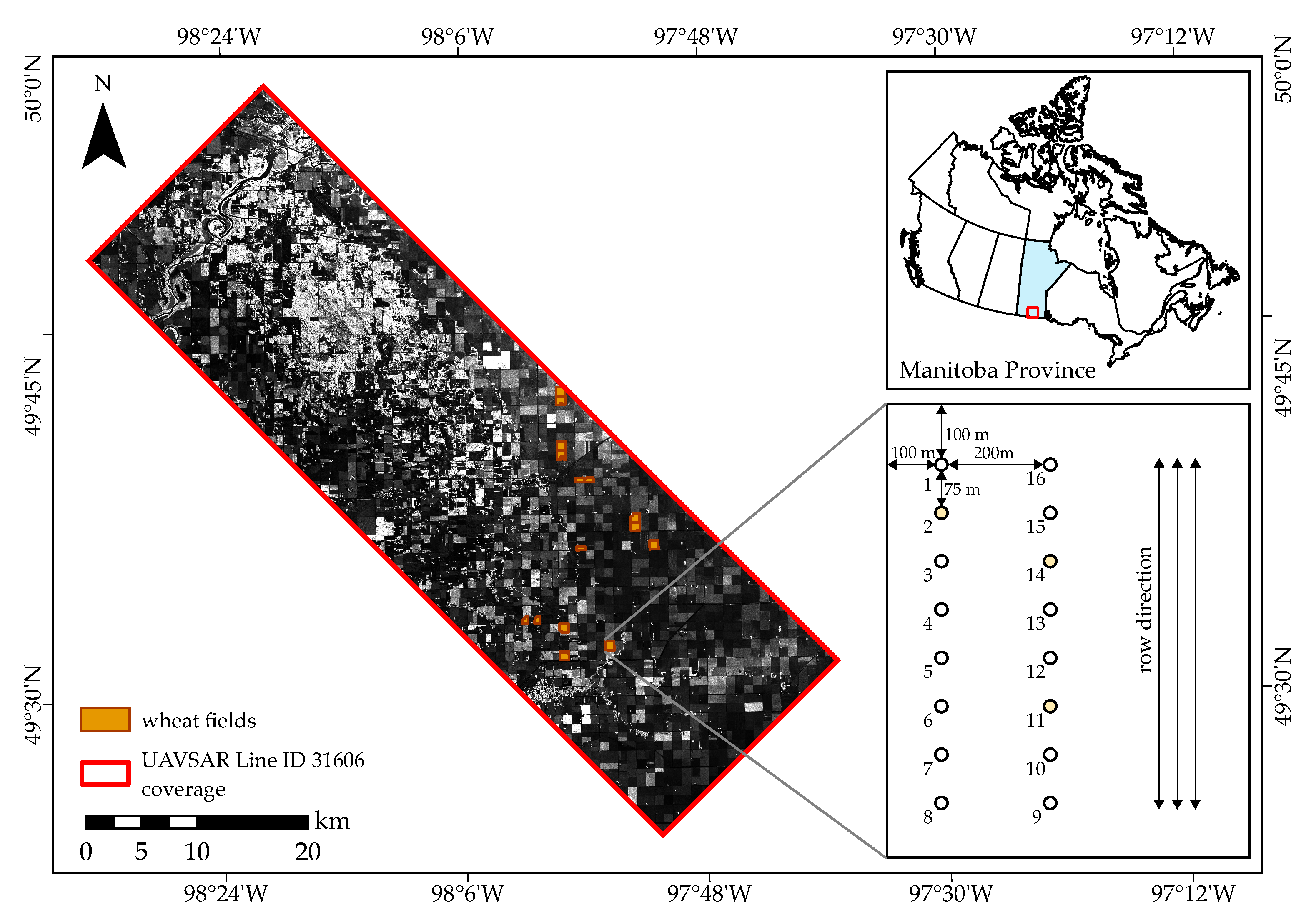
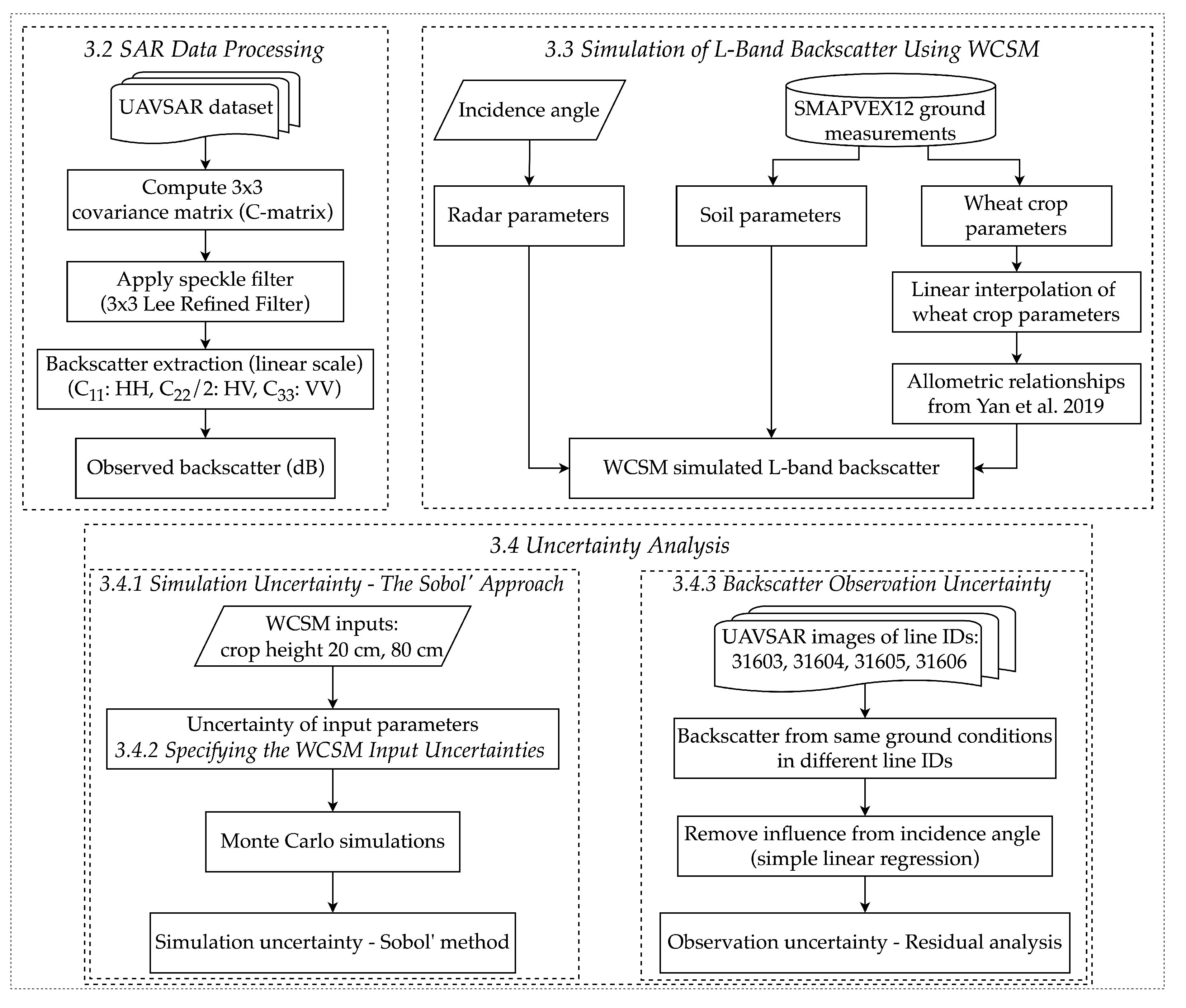
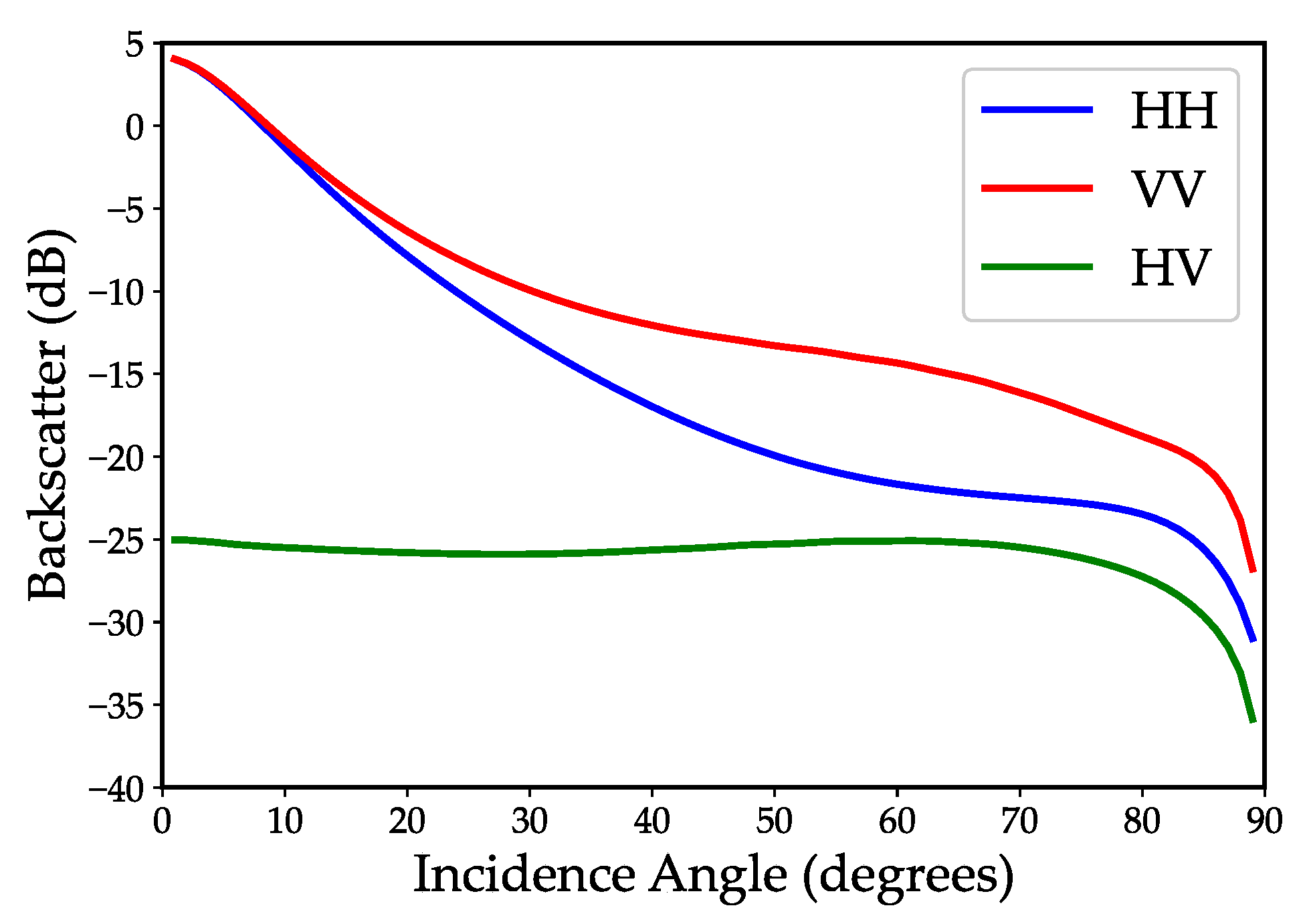

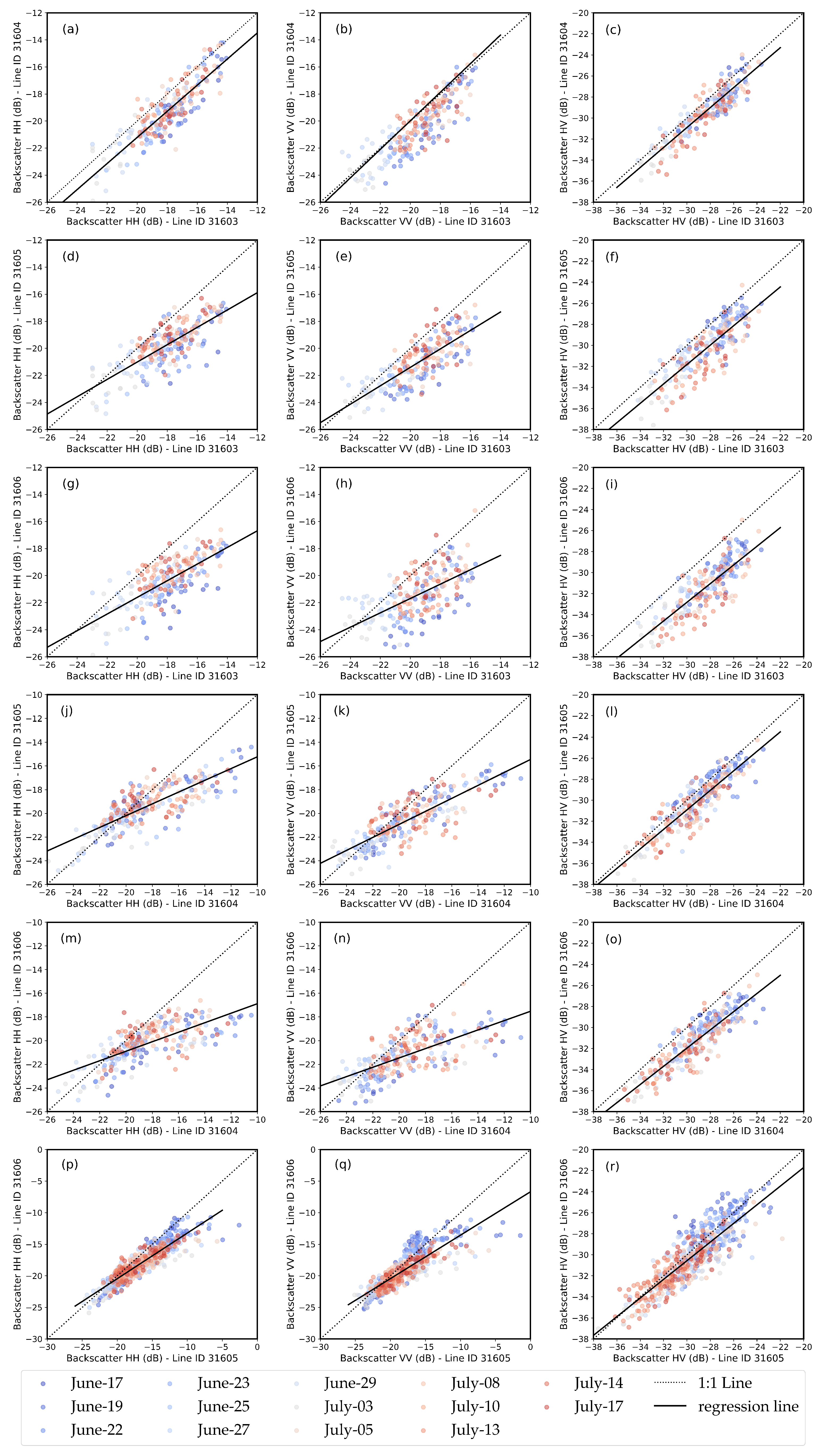
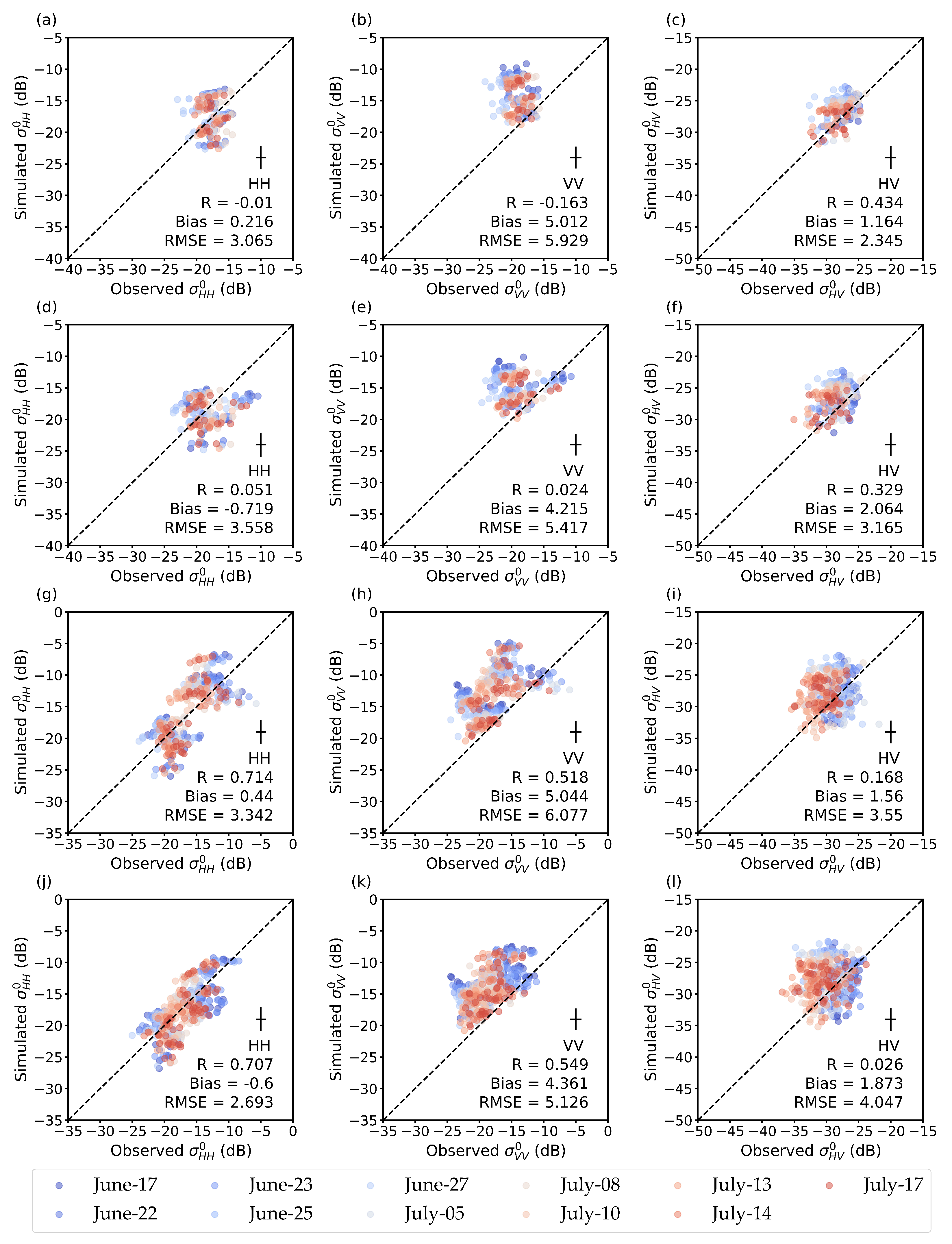

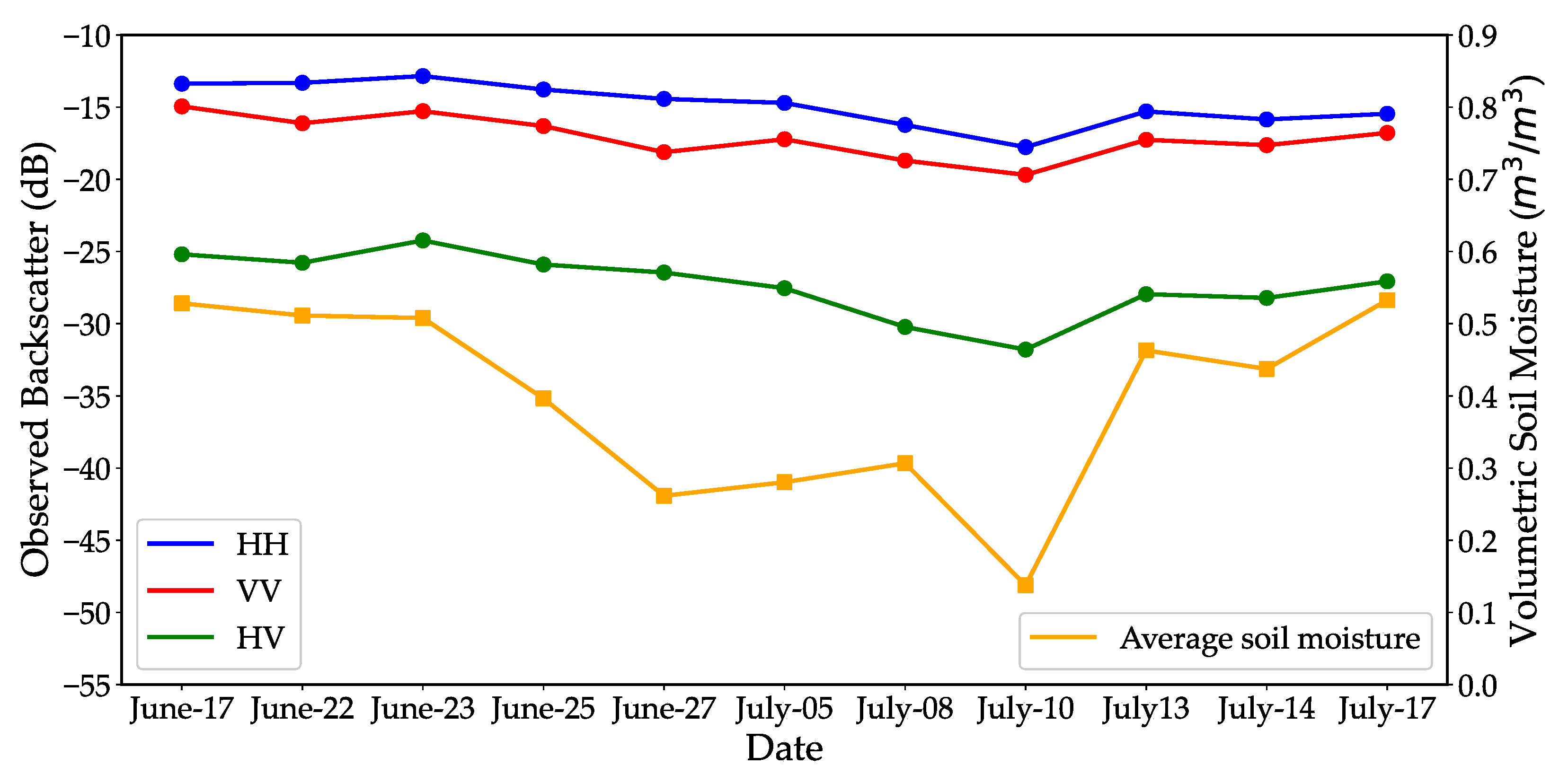

| Item | Parameters | SMAPVEX12 Measurement Availability |
|---|---|---|
| Canopy | Height Crop density | Measured 1 Measured |
| Panicle | Height | Derived 2 |
| Ear | Height Diameter Gravimetric water content | Derived Derived Measured |
| Leaf | Length Width Thickness Gravimetric water content | Derived Derived Derived Measured |
| Stem | Height Diameter Gravimetric water content | Derived Measured Measured |
| Soil | Volumetric moisture content Temperature Soil texture (sand and clay contents) Root mean square (RMS) height Correlation length | Measured Measured Measured Measured Measured |
| Radar | Frequency Incidence angle | Available 3 Available |
| Day of Year (DOY) | UAVSAR Acquisition Date | Flight ID |
|---|---|---|
| 169 * | 17 June 2012 | 12044 |
| 171 | 19 June 2012 | 12045 |
| 174 * | 22 June 2012 | 12046 |
| 175 * | 23 June 2012 | 12047 |
| 177 * | 25 June 2012 | 12048 |
| 179 * | 27 June 2012 | 12049 |
| 181 | 29 June 2012 | 12050 |
| 185 | 3 July 2012 | 12055 |
| 187 * | 5 July 2012 | 12056 |
| 190 * | 8 July 2012 | 12057 |
| 192 * | 10 July 2012 | 12058 |
| 195 * | 13 July 2012 | 12059 |
| 196 * | 14 July 2012 | 12060 |
| 199 * | 17 July 2012 | 12061 |
| Input Parameter | Value | Uncertainty (1 Standard Deviation) |
|---|---|---|
| Crop density (number of stems/m2) * | 383 | 20 |
| Crop height (cm) * | 80 | 5 |
| Panicle height (cm) | 10 | 1 |
| Ear height (cm) | 8.5 | 0.27 |
| Ear diameter (cm) | 1.1 | 0.074 |
| Ear water content fraction * | 0.5 | 0.03 |
| Leaf length (cm) * | 20 | 1 |
| Leaf width (cm) * | 1.2 | 0.5 |
| Leaf thickness (cm) * | 0.02 | 0.002 |
| Leaf water content fraction * | 0.65 | 0.03 |
| Stem height (cm) | 67 | 1.73 |
| Stem diameter (cm) | 0.33 | 0.02 |
| Stem water content fraction * | 0.65 | 0.03 |
| RMS height (cm) | 0.8 | 0.2 |
| Correlation length (cm) | 12 | 1 |
| Surface temperature (°C) | 16.5 | 2 |
| Soil moisture (m3/m3) * | 0.25 | 0.025 |
| Incidence angle (degrees) | 35 | 2 |
| Sand content (%) | 15 | 5 |
| Clay content (%) | 43 | 5 |
| Simulation uncertainty (dB) | 1.88 | 1.73 | 1.80 |
| Line ID Combination | Observation Uncertainty (dB) | ||
|---|---|---|---|
| 31604 vs. 31603 | 0.761 | 0.754 | 0.718 |
| 31605 vs. 31603 | 0.758 | 0.746 | 0.970 |
| 31606 vs. 31603 | 0.815 | 0.971 | 0.970 |
| 31605 vs. 31604 | 0.765 | 0.764 | 0.794 |
| 31606 vs. 31604 | 0.808 | 0.903 | 0.782 |
| 31606 vs. 31605 | 0.863 | 1.071 | 0.948 |
| Observation uncertainty (dB) | 0.80 | 0.87 | 0.86 |
| Simulation uncertainty (dB) | 1.88 | 1.73 | 1.80 |
| Total uncertainty (dB) | 2.68 | 2.60 | 2.66 |
| RMSE between simulated and observed backscatter (dB) | 3.17 | 5.63 | 3.27 |
Disclaimer/Publisher’s Note: The statements, opinions and data contained in all publications are solely those of the individual author(s) and contributor(s) and not of MDPI and/or the editor(s). MDPI and/or the editor(s) disclaim responsibility for any injury to people or property resulting from any ideas, methods, instructions or products referred to in the content. |
© 2025 by the authors. Licensee MDPI, Basel, Switzerland. This article is an open access article distributed under the terms and conditions of the Creative Commons Attribution (CC BY) license (https://creativecommons.org/licenses/by/4.0/).
Share and Cite
Wijesinghe, L.; Western, A.W.; Aryal, J.; Ryu, D. Can Measurement and Input Uncertainty Explain Discrepancies Between the Wheat Canopy Scattering Model and SMAPVEX12 Observations? Remote Sens. 2025, 17, 164. https://doi.org/10.3390/rs17010164
Wijesinghe L, Western AW, Aryal J, Ryu D. Can Measurement and Input Uncertainty Explain Discrepancies Between the Wheat Canopy Scattering Model and SMAPVEX12 Observations? Remote Sensing. 2025; 17(1):164. https://doi.org/10.3390/rs17010164
Chicago/Turabian StyleWijesinghe, Lilangi, Andrew W. Western, Jagannath Aryal, and Dongryeol Ryu. 2025. "Can Measurement and Input Uncertainty Explain Discrepancies Between the Wheat Canopy Scattering Model and SMAPVEX12 Observations?" Remote Sensing 17, no. 1: 164. https://doi.org/10.3390/rs17010164
APA StyleWijesinghe, L., Western, A. W., Aryal, J., & Ryu, D. (2025). Can Measurement and Input Uncertainty Explain Discrepancies Between the Wheat Canopy Scattering Model and SMAPVEX12 Observations? Remote Sensing, 17(1), 164. https://doi.org/10.3390/rs17010164









